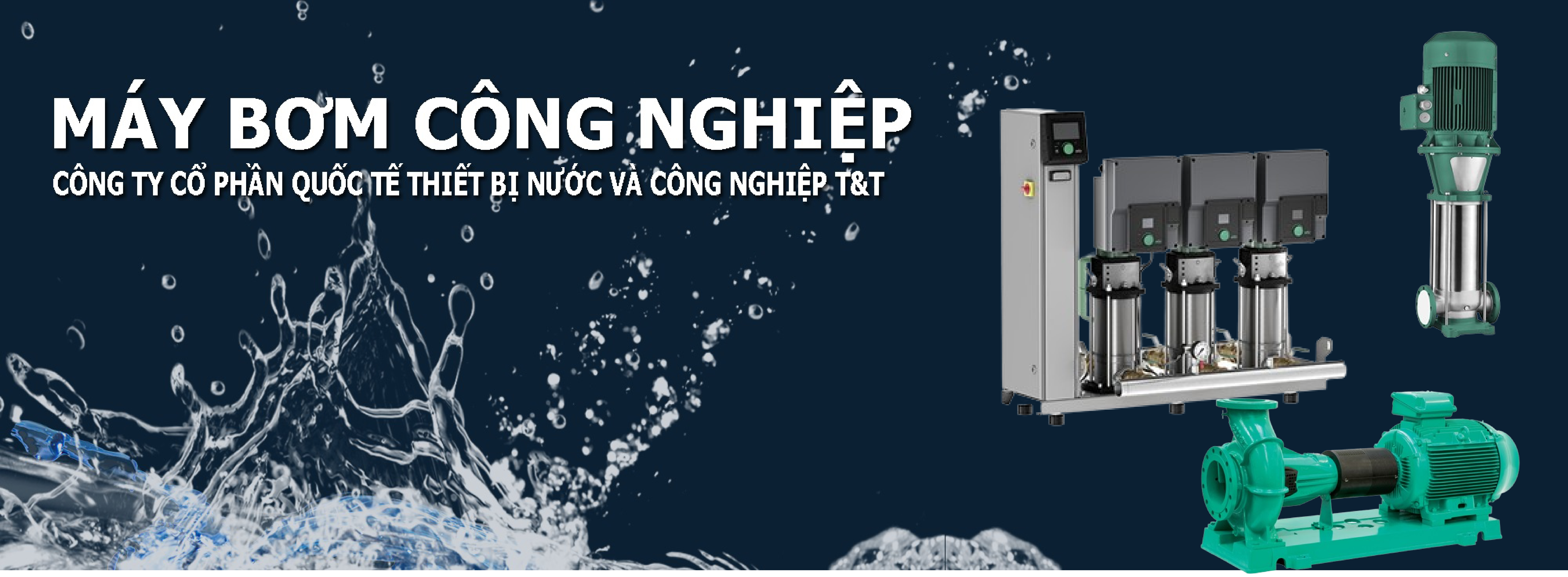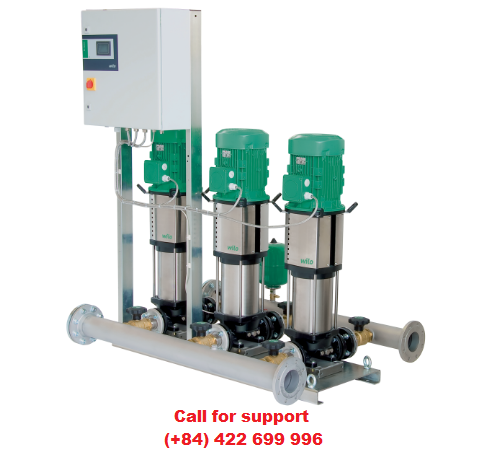Comfort CO-/COR-Helix V.../CC
Giá: Liên hệ
Design
Highly efficient, ready for connection water-supply unit (non self-priming) with 2 to 6 vertically arranged glanded stainless steel high-pressure multistage centrifugal pumps from the Helix V series switched in parallel, including Comfort Controller CC (available with and without frequency converter)
Application
- Fully automatic water supply and pressure boosting in residential, commercial and public buildings, hotels, hospitals, department stores and for industrial systems.
- Pumping of drinking water and process water, cooling water, fire water (apart from fire-extinguishing systems in accordance with DIN 14462 and with the approval of the local fire safety authorities) or other types of industrial water that do not attack the materials either chemically or mechanically and do not contain abrasive or long-fibre constituents.
Design
Highly efficient, ready for connection water-supply unit (non self-priming) with 2 to 6 vertically arranged glanded stainless steel high-pressure multistage centrifugal pumps from the Helix V series switched in parallel, including Comfort Controller CC (available with and without frequency converter)
Application
- Fully automatic water supply and pressure boosting in residential, commercial and public buildings, hotels, hospitals, department stores and for industrial systems.
- Pumping of drinking water and process water, cooling water, fire water (apart from fire-extinguishing systems in accordance with DIN 14462 and with the approval of the local fire safety authorities) or other types of industrial water that do not attack the materials either chemically or mechanically and do not contain abrasive or long-fibre constituents.
Pump characteristic
.png)
Type key
.png)
Type key
| Example: | Wilo-COR-4 Helix V 2203/1/K/CC |
|---|---|
| CO | Compact pressure boosting system |
| R | Control of the respective base-load pump via frequency converter in the switchgear |
| 4 | Number of pumps |
| Helix V | Pump series |
| 22 | Rated volume flow [m3/h] of the single pump |
| 03 | Number of single-pump stages |
| 1 | Number of trimmed impellers of a pump |
| K | With cartridge mechanical seal |
| CC | Control unit; CC = Comfort Controller |
Special features/product advantages
- Heavy-duty system in accordance with DIN 1988 (EN 806)
- High-efficiency pump hydraulics
- Pressure-loss optimised entire system2 to 6 vertical Helix V series stainless steel high-pressure multistage centrifugal pumps switched in parallel
- Comfort CC control / regulation unit with extended functions, microcomputer and touchscreen, with or without frequency converter for infinitely variable control of the base-load pump
- High-efficiency pump hydraulics
- Pressure-loss optimised entire system2 to 6 vertical Helix V series stainless steel high-pressure multistage centrifugal pumps switched in parallel
- Comfort CC control / regulation unit with extended functions, microcomputer and touchscreen, with or without frequency converter for infinitely variable control of the base-load pump
Technical data
- Mains connection 3~230 V/400 V ± 10%, 50 Hz
- Max. fluid temperature 50 °C (70 °C optional)
- Operating pressure 16 bar (25 bar optional)
- Inlet pressure 10 bar
- Nominal connection diameters on discharge side R 1½ ‐ DN 200
- Nominal connection diameter on the intake side R 1½" - DN 200
- Rated speed 2850 rpm
- Protection class IP 54 (CC control device)
- Fuse protection on mains side AC 3 according to motor power and EVU regulations
- Approved fluids (other fluids on request):
- Drinking water and domestic hot water
- Cooling water
- Fire water
Note on fluids: Approved fluids are generally water mixtures which do not chemically or mechanically attack the materials used and do not contain either abrasive or fibrous matter
- Max. fluid temperature 50 °C (70 °C optional)
- Operating pressure 16 bar (25 bar optional)
- Inlet pressure 10 bar
- Nominal connection diameters on discharge side R 1½ ‐ DN 200
- Nominal connection diameter on the intake side R 1½" - DN 200
- Rated speed 2850 rpm
- Protection class IP 54 (CC control device)
- Fuse protection on mains side AC 3 according to motor power and EVU regulations
- Approved fluids (other fluids on request):
- Drinking water and domestic hot water
- Cooling water
- Fire water
Note on fluids: Approved fluids are generally water mixtures which do not chemically or mechanically attack the materials used and do not contain either abrasive or fibrous matter
|
Equipment/function - 2-6 pumps per system of the Helix V 4 to Helix V 52 series with IE2 standard motor, including 7.5 kW and larger IE3 standard motor (optional for smaller motor power)
- Automatic pump control via Comfort Controller CC. The COR systems are additionally equipped with a frequency converter in the switch cabinet.Parts that come in contact with the fluid are corrosion-resistant - Base frame made of galvanised steel, with height-adjustable vibration absorbers for insulation against structure-borne noise - Pipework made of 1.4571 stainless steel - Shut-off valve on the suction and pressure sides of each pump - Non-return valve on the pressure side of each pump - Diaphragm pressure vessel 8 l, PN16, pressure side - Pressure sensor, pressure side - Pressure gauge, pressure side - Optional low-water cut-out switchgear with pressure gauge, suction side |
|
Description/design - Base frame: galvanised steel, with height-adjustable vibration absorbers for comprehensive insulation against structure-borne noise; other versions on request
- Pipework: complete pipework made of stainless steel, suitable for the connection of all piping materials used; the pipework is dimensioned according to the overall hydraulic performance of the pressure boosting system - Pumps: 2 to 6 pumps switched in parallel of the Helix V 4 to Helix V 52 series; all parts which come into contact with the fluid are made of stainless steel; other versions on request. KTW/WRAS/ACS approval for all parts that come in contact with the fluid - Valves: each pump is fitted on the suction and pressure side with a shut-off valve or a shut-off flap with DVGW approval mark and on the pressure side with a DVGW/KTW-approved non-return valve - Diaphragm pressure vessel: 8 l/PN16 arranged on the discharge side with a diaphragm made of butyl rubber, with DVGW/KTW approval, completely safe in accordance with food safety laws, for testing and inspection purposes, with drain and throughflow valve with DVGW/KTW approval in accordance with DIN 4807 - Pressure sensor: 4 to 20 mA, located on the discharge side for controlling the central Comfort Controller CC - Pressure indication: pressure gauge (∅ 63 mm) arranged on the discharge side; additional digital indication of the discharge pressure on the alphanumeric touchscreen on the Comfort Controller - Control device/controller; The system is equipped with a Comfort Controller CC as standard; COR additionally with a frequency converter |
|
Materials Helix V 4 to Helix V 52
- Impellers, guide vane apparatuses, stage housing made of stainless steel 1.4307 - Pump housing of stainless steel 1.4301 - Shaft of stainless steel 1.4057 - 1.4404 shaft protection sleeve - O-Ring gaskets made of EPDM (FKM gasket on request) - Pipework made of 1.4571 stainless steel |
|
Scope of delivery - Factory-mounted, connection-ready pressure boosting system checked for functionality and impermeability
- Packaging - Installation and operating instructions |
|
Options - Factory-mounted, connection-ready pressure boosting system checked for functionality and impermeability
- Packaging - Installation and operating instructions - Transport eyes for self-assembly |
|
Consulting guide - Pressure reducer
- Excessively high or a heavily fluctuating inlet pressure will require the installation of a pressure reducer to maintain a constant minimum inlet pressure level. Permitted inlet pressure fluctuation max. 1.0 bar - Volume flowUp to 400 m3/h (111 l/s) system configuration in accordance with DIN 1988 (EN 806); with standby pump up to 480 m3/h (133 l/s) during operation of the standby pump as an auxiliary peak-load unit. - Inlet pressure - The maximum inlet pressure must be taken into account when designing the system configuration. The maximum inlet pressure is calculated from the maximum system operating pressure minus the maximum pump delivery head at Q = 0. - Low-water cut-out switchgear (WMS) - In accordance with DIN 1988 (EN 806) the installation of a WMS low-water cut-out switchgear is required in cases where the pressure boosting systems are connected directly to a public mains power supply; this prevents any possible lowering of the inlet pressure in the mains supply line to values less than 1.0 bar. Please make sure to include this with the initial order for the pressure boosting system. The WMS will then be installed in the pressure boosting system, electrically wired and fully tested by Wilo during the final functional test. - Residual-current-operated protection switch - When installing residual-current-operated protection switches in conjunction with frequency converters, bear in mind that only universal-current-sensitive residual-current-operated protection switches in accordance with DIN/VDE 0664 are to be fitted. - Standards/directives The overall system conforms with the requirements of - DIN 1988 Part 5 - DIN 1988 Part 6* (**) * The specifications in DIN 1988 (EN 806) and of the water-supply companies are to be observed. Regarding the electrical components, the system conforms with the requirements of - VDE 0100 Part 430/Part 540 - VDE 0110 Part 1/Part 2 - VDE 0660 Part 101/Part 107 and - DIN 40719/IEC 754 Always observe the specifications in DIN 1988 (EN 806) when using and operating the pressure boosting system. (**)This does not apply to fire-extinguishing systems in accordance with DIN14462. Please request these separately. |



